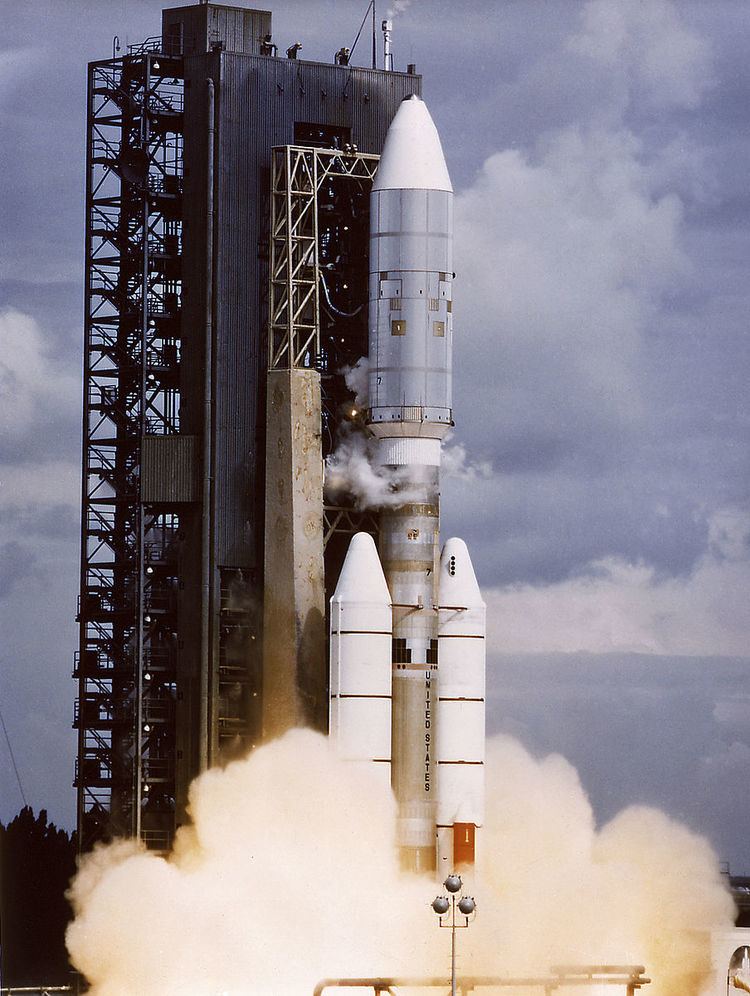Height 48 m (157 ft) | Country of origin United States Diameter 3.05 m (10.0 ft) | |
 | ||
Mass 632,970 kg (1,395,460 lb) | ||
The Titan IIIE or Titan 3E, also known as Titan III-Centaur was an American expendable launch system. Launched seven times between 1974 and 1977, it enabled several high-profile NASA missions, including the Voyager and Viking planetary probes, and the joint West German-US Helios spacecraft. All seven launches were conducted from Launch Complex 41 at Cape Canaveral.
Contents
Development
In 1967, NASA began considering the possibility of combining the massive Titan III booster and Centaur high-energy upper stage to create what was at the time the most powerful launch vehicle for planetary exploration. With over three times the payload capacity of the Atlas-Centaur, Titan IIIE would be able to launch ambitious robotic spacecraft missions planned for the 1970s.
NASA's Lewis Research Center (now the Glenn Research Center) was given the task of integrating Titan with Centaur, which required a number of modifications to accommodate the more powerful booster. The most obvious change was enclosing Centaur in a large shroud that protected the stage and the payload during ascent. This enabled the use of improved insulation on Centaur, which increased coast time in orbit from 30 minutes when launched on Atlas to over 5 hours on the Titan IIIE. Since Centaur was wider than the Titan's core stage, a tapering interface was required. This interface had to be insulated to prevent boiloff of Centaur's cryogenic propellants, since Titan used hypergolic propellants stored at ambient temperature, while Atlas used liquid oxygen. The Centaur stage also contained the guidance computer for the entire launch vehicle.
A four-stage configuration, with an additional upper stage, a Star-37E, was also available, and was used for the two Helios launches. Star-37E stages were also used on the two Voyager launches, but were considered to be part of the payload rather than the rocket.
Flights
The first Titan IIIE launch occurred on February 11, 1974. Original plans were to fly a boilerplate Viking probe, but NASA decided to add a secondary payload: a test satellite called SPHINX (Space Plasma High Voltage Interaction Experiment) which was intended to test the operation of high voltage power supplies in the vacuum of space. The Titan performed normally, but the Centaur's engines failed to start. Ground controllers waited for a minute, then issued a manual start command but still nothing happened. With the Centaur descending back towards Earth, the range safety destruct command was sent from a radar station in Antigua.
The failure was traced to the Centaur boost pumps, but the cause was still unclear, thought likely to be either ice or debris. To reduce the chance of another similar failure, pre-launch procedures to verify Centaur's pumps were free and unobstructed were put in place. It took nearly four years to trace the cause of the failure, which was an improperly-installed mounting bracket inside the LOX tank. This bracket held a LOX regulator in place and the technician responsible for installing it had found that the normal tool used to screw bolts into place was too short to reach the bracket. He thus used a slightly longer socket wrench which gave him more reach. The technician had since retired and failed to inform his successor about this. The new technician thus attempted to attach the bolt with the wrench specified in the assembly instructions, which was too short and prevented him from screwing it into place properly. The bolt came loose, fell off, and got sucked into one of the LOX boost pumps, jamming it and preventing it from operating. Despite the failure, at least one important goal was accomplished in that the bulging Centaur payload shroud was proven to be aerodynamically stable in flight and had jettisoned properly and on schedule.
The next flight of the Titan IIIE was on December 10, 1974, carrying the Helios-A spacecraft. This mission was successful, as were all subsequent launches.
Voyager 1's launch almost ended in failure when a fuel line obstruction caused low thrust in the Titan second stage. The launch vehicle had a velocity shortfall of about 544 feet per second and was some 3000 feet below the intended altitude at cutoff, the result of which the Centaur had to burn far longer than intended to compensate. At cutoff, it was a mere 3.5 seconds from propellant exhaustion. That the mission ultimately succeeded was due to the favorable position of Jupiter vis-a-vis the Earth on launch day. If the same failure had occurred on Voyager 2's launch a few weeks earlier, the Centaur would have run out of propellant trying to put the probe on the correct trajectory.
